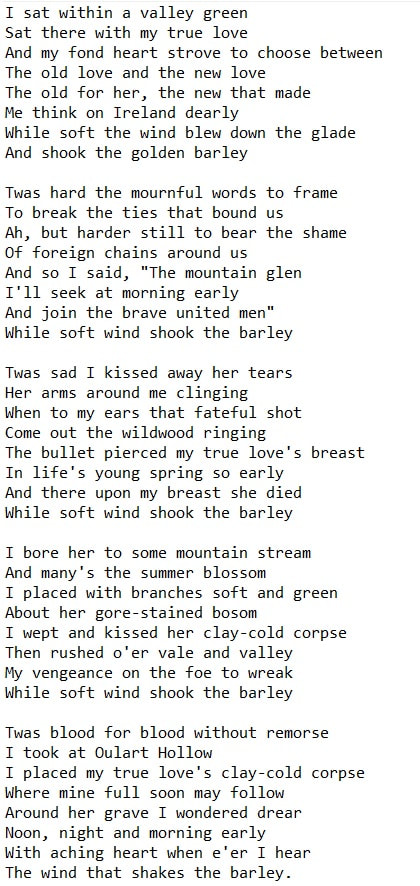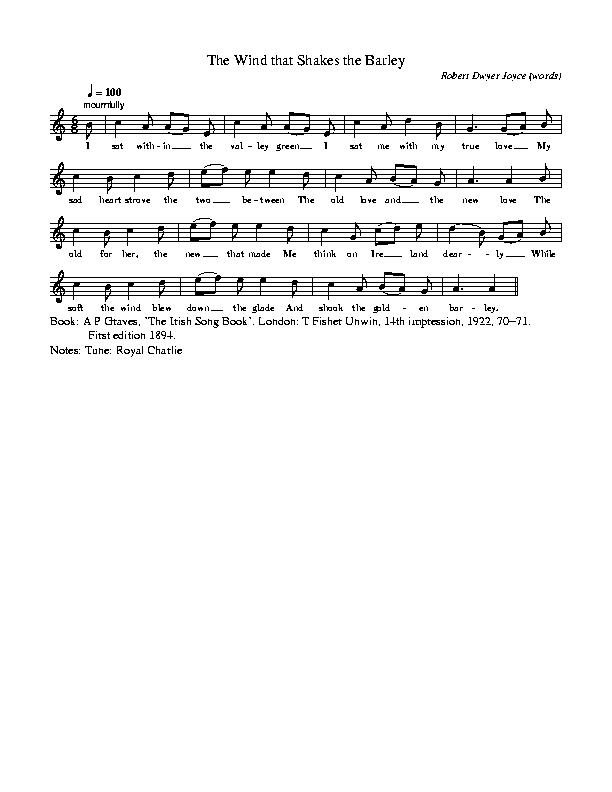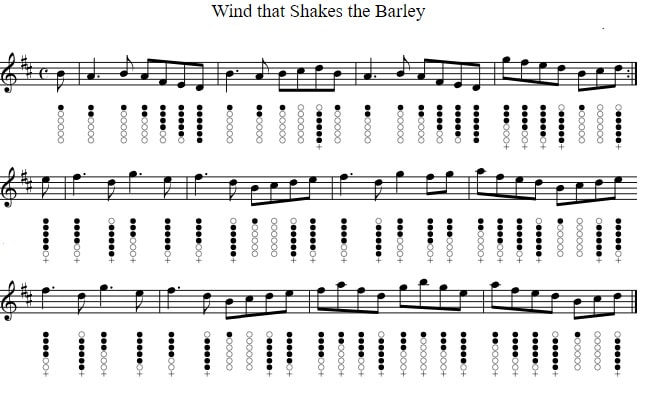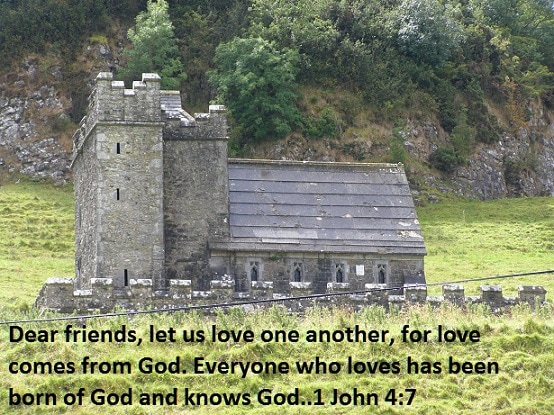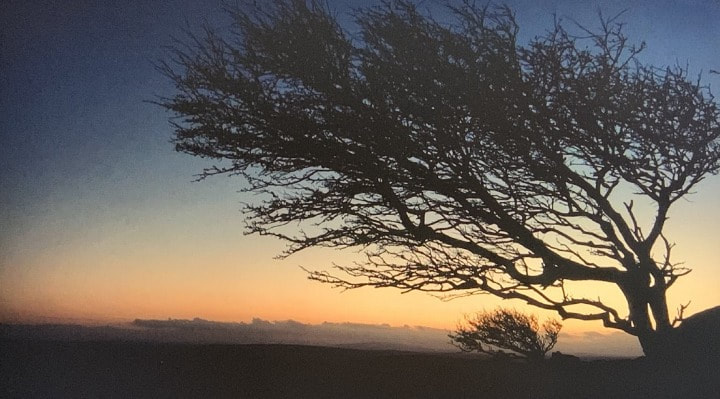The Wind That Shakes The Barley Lyrics Chords And Music
By Robert Dwyer Joyce. An Irish love song.The guitar chords are in the key of Dm in chordpro. This one goes back to the 1860s an commemorates the 1798 rising. The sheet music and tin whistle notes are included. Boolavogue song is also written about the events that took place during the 1798 rebellion in Ireland.
[Dm]I sat with[Gm]in a[Dm] valley[Am green
[Dm]Sat there[C] with my[Dm] true love
And my fond heart[Gm] strove to[Dm] choose be[Am]tween
The[Dm] old love[C] and the[Dm] new love
The old for her, the[C] new that made
Me[Bb] think on Ireland[Am] dearly
While[Dm] soft the[Gm] wind blew[Dm] down the[Am] glade
And[Dm] shook the[C] golden[Dm] barley
Twas hard the mournful words to frame
To break the ties that bound us
Ah, but harder still to bear the shame
Of foreign chains around us
And so I said, "The mountain glen
I'll seek at morning early
And join the brave united men"
While soft wind shook the barley
Twas sad I kissed away her tears
Her arms around me clinging
When to my ears that fateful shot
Come out the wildwood ringing
The bullet pierced my true love's breast
In life's young spring so early
And there upon my breast she died
While soft wind shook the barley
I bore her to some mountain stream
And many's the summer blossom
I placed with branches soft and green
About her gore-stained bosom
I wept and kissed her clay-cold corpse
Then rushed o'er vale and valley
My vengeance on the foe to wreak
While soft wind shook the barley
Twas blood for blood without remorse
I took at Oulart Hollow
I placed my true love's clay-cold corpse
Where mine full soon may follow
Around her grave I wondered drear
Noon, night and morning early
With aching heart when e'er I hear
The wind that shakes the barley.
[Dm]Sat there[C] with my[Dm] true love
And my fond heart[Gm] strove to[Dm] choose be[Am]tween
The[Dm] old love[C] and the[Dm] new love
The old for her, the[C] new that made
Me[Bb] think on Ireland[Am] dearly
While[Dm] soft the[Gm] wind blew[Dm] down the[Am] glade
And[Dm] shook the[C] golden[Dm] barley
Twas hard the mournful words to frame
To break the ties that bound us
Ah, but harder still to bear the shame
Of foreign chains around us
And so I said, "The mountain glen
I'll seek at morning early
And join the brave united men"
While soft wind shook the barley
Twas sad I kissed away her tears
Her arms around me clinging
When to my ears that fateful shot
Come out the wildwood ringing
The bullet pierced my true love's breast
In life's young spring so early
And there upon my breast she died
While soft wind shook the barley
I bore her to some mountain stream
And many's the summer blossom
I placed with branches soft and green
About her gore-stained bosom
I wept and kissed her clay-cold corpse
Then rushed o'er vale and valley
My vengeance on the foe to wreak
While soft wind shook the barley
Twas blood for blood without remorse
I took at Oulart Hollow
I placed my true love's clay-cold corpse
Where mine full soon may follow
Around her grave I wondered drear
Noon, night and morning early
With aching heart when e'er I hear
The wind that shakes the barley.
: Nationalism and Rebellion in Ireland
The Wind That Shakes The Barley, a film directed by Ken Loach, depicts the struggles of Irish nationalists during the early 20th century. Set during the Irish War of Independence and the Irish Civil War, the film explores the themes of nationalism and rebellion in Ireland. Through its portrayal of the brutalities of war and the complex relationships between the Irish people and the British, The Wind That Shakes The Barley offers a powerful commentary on the impact of political ideologies on individuals and society as a whole. This thesis will delve into the historical context of the film and analyze how it reflects the complexities of Irish nationalism and rebellion.
The film is set in the early 1920s, a time when Ireland was in the midst of a struggle for independence from British rule. The British had been in control of Ireland for centuries, imposing their laws and customs on the Irish people. This led to resentment and a desire for self-governance among the Irish, which ultimately culminated in the Irish War of Independence. The film follows the story of two brothers, Damien and Teddy O'Donovan, who are involved in the Irish Republican Army (IRA) and their fight against the British forces.
One of the central themes of The Wind That Shakes The Barley is Irish nationalism. The film portrays the strong sense of national identity and pride among the Irish people, who are determined to fight for their country's independence. This is reflected in the characters of Damien and Teddy, who are willing to risk their lives for the cause. The film also highlights the role of cultural traditions and heritage in shaping Irish nationalism. The use of traditional Irish music and language throughout the film serves as a reminder of the strong cultural ties that bind the Irish people together.
The film also explores the complexities of rebellion and the consequences it has on individuals and society. While the Irish people are united in their fight against the British, there are internal divisions and conflicts within the IRA. The division between the 'Irregulars' and the 'Treatyites' mirrors the political divide between those who supported the Anglo-Irish Treaty and those who opposed it. This divide ultimately leads to the Irish Civil War, which is depicted in the later part of the film. The film shows how rebellion and revolution can often result in violence and division, even among those fighting for the same cause.
Furthermore, The Wind That Shakes The Barley also sheds light on the complexities of the relationship between the Irish people and the British. The film portrays the brutalities of the British forces, who are determined to quell the Irish rebellion at any cost. The scene where a group of Irish men are executed by the British for possessing firearms is a powerful depiction of the atrocities committed by the British during this period. The film also shows the impact of British policies, such as the Black and Tans, which further fueled the nationalist sentiment among the Irish.
The film also highlights the role of women in the Irish struggle for independence. The character of Sinead, a young woman who becomes involved in the IRA, represents the many women who played vital roles in the fight for Irish independence. Sinead's character also challenges traditional gender roles and shows the strength and determination of Irish women in the face of adversity.
In addition to its portrayal of Irish nationalism and rebellion, The Wind That Shakes The Barley also raises important questions about the concept of nationhood and the role of violence in achieving political goals. The film shows how the Irish people were willing to sacrifice their lives for their country's independence, but also questions the morality of using violence as a means to an end. The final scene, where Damien walks away from the IRA and chooses to live a peaceful life, is a poignant commentary on the human cost of armed rebellion.
In conclusion, The Wind That Shakes The Barley is a powerful and thought-provoking film that explores the themes of nationalism and rebellion in Ireland. Through its vivid portrayal of the struggles of the Irish people during a tumultuous period in their history, the film highlights the complexities of political ideologies and their impact on individuals and society. The film serves as a reminder of the sacrifices made by the Irish people in their fight for independence and the enduring spirit of Irish nationalism.
The Wind That Shakes The Barley, a film directed by Ken Loach, depicts the struggles of Irish nationalists during the early 20th century. Set during the Irish War of Independence and the Irish Civil War, the film explores the themes of nationalism and rebellion in Ireland. Through its portrayal of the brutalities of war and the complex relationships between the Irish people and the British, The Wind That Shakes The Barley offers a powerful commentary on the impact of political ideologies on individuals and society as a whole. This thesis will delve into the historical context of the film and analyze how it reflects the complexities of Irish nationalism and rebellion.
The film is set in the early 1920s, a time when Ireland was in the midst of a struggle for independence from British rule. The British had been in control of Ireland for centuries, imposing their laws and customs on the Irish people. This led to resentment and a desire for self-governance among the Irish, which ultimately culminated in the Irish War of Independence. The film follows the story of two brothers, Damien and Teddy O'Donovan, who are involved in the Irish Republican Army (IRA) and their fight against the British forces.
One of the central themes of The Wind That Shakes The Barley is Irish nationalism. The film portrays the strong sense of national identity and pride among the Irish people, who are determined to fight for their country's independence. This is reflected in the characters of Damien and Teddy, who are willing to risk their lives for the cause. The film also highlights the role of cultural traditions and heritage in shaping Irish nationalism. The use of traditional Irish music and language throughout the film serves as a reminder of the strong cultural ties that bind the Irish people together.
The film also explores the complexities of rebellion and the consequences it has on individuals and society. While the Irish people are united in their fight against the British, there are internal divisions and conflicts within the IRA. The division between the 'Irregulars' and the 'Treatyites' mirrors the political divide between those who supported the Anglo-Irish Treaty and those who opposed it. This divide ultimately leads to the Irish Civil War, which is depicted in the later part of the film. The film shows how rebellion and revolution can often result in violence and division, even among those fighting for the same cause.
Furthermore, The Wind That Shakes The Barley also sheds light on the complexities of the relationship between the Irish people and the British. The film portrays the brutalities of the British forces, who are determined to quell the Irish rebellion at any cost. The scene where a group of Irish men are executed by the British for possessing firearms is a powerful depiction of the atrocities committed by the British during this period. The film also shows the impact of British policies, such as the Black and Tans, which further fueled the nationalist sentiment among the Irish.
The film also highlights the role of women in the Irish struggle for independence. The character of Sinead, a young woman who becomes involved in the IRA, represents the many women who played vital roles in the fight for Irish independence. Sinead's character also challenges traditional gender roles and shows the strength and determination of Irish women in the face of adversity.
In addition to its portrayal of Irish nationalism and rebellion, The Wind That Shakes The Barley also raises important questions about the concept of nationhood and the role of violence in achieving political goals. The film shows how the Irish people were willing to sacrifice their lives for their country's independence, but also questions the morality of using violence as a means to an end. The final scene, where Damien walks away from the IRA and chooses to live a peaceful life, is a poignant commentary on the human cost of armed rebellion.
In conclusion, The Wind That Shakes The Barley is a powerful and thought-provoking film that explores the themes of nationalism and rebellion in Ireland. Through its vivid portrayal of the struggles of the Irish people during a tumultuous period in their history, the film highlights the complexities of political ideologies and their impact on individuals and society. The film serves as a reminder of the sacrifices made by the Irish people in their fight for independence and the enduring spirit of Irish nationalism.
Included below is a PDF for the sheet music of The Wind That Shakes The Barley.
